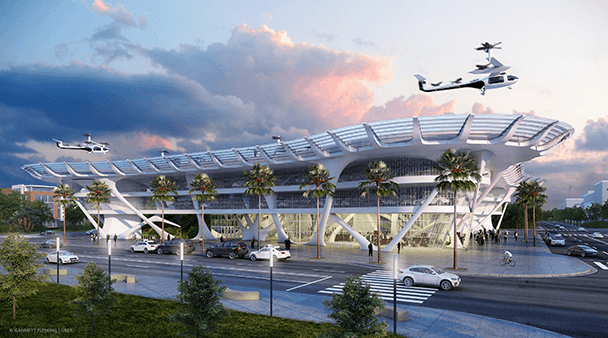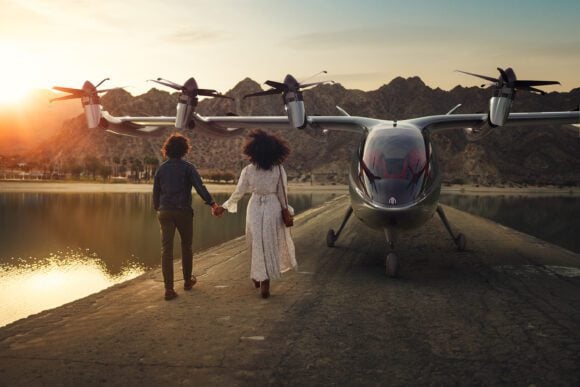
Vehicle Approach 1finalcompressed
Uber has demonstrated the commitment to make Uber Air, an aerial ridesharing service, a reality. They have more than $20 million invested in the Uber Elevate program and more than 100 dedicated staff. Uber has the brand, the will, and the partners to make good on the promise to launch Uber Air, flights in 2023.
Uber created the Uber Elevate Network with partners to launch fleets of small, electric VTOL (vertical takeoff and landing) aircraft in Dallas, Los Angeles, and the first international market in Melbourne, Australia. Uber is focused on the critical path to address the issues of safety, noise, public acceptance, and customer services to make aerial ridesharing service a reality.
Uber and UAM
Uber was founded with a simple vision: tap a button, get a ride. Uber has since evolved into a transportation network that helps passengers get from point A to point B by car, bike, scooter, and public transit—and, in the not-so-distant future, flights.
Uber Air is Uber’s most ambitious vision for the future. Uber Air would take to the sky to alleviate congestion on the ground and enable riders to tap a button for a shared flight, just like the Uber car services around the world.
Uber is leading the industry in promoting Urban Air Mobily (UAM) and the future for intra-metropolitan area passenger aerial transportation. The white paper, Fast-Forwarding to a Future of On-Demand Urban Air Transportation, released in 2016 launched industry discussions as to the viability of on-demand urban air transportation within metropolitan areas. In 2017, Uber held the first Uber Elevate conference to bring to the forefront the multiple issues surrounding aircraft within urban environments. This year’s Uber Elevate conference was held in Washington, D.C. and featured three days of high-level and technical presentations relating to UAM for the more than 1,100 attendees.
Uber Aircraft Partners
Like the car rideshare service, Uber does not intend to develop, own, or operate UAM aircraft. Uber has partnerships with six aircraft manufacturers. Three are legacy aerospace companies, Boeing/Aurora, Bell, and Embraer, while the others are less well-known new entrants to the aerospace market and include Karem Aircraft, Pipistrel, and Jaunt Air Mobility. None of these aircraft have been issued airworthiness certification by the FAA or other aircraft certification agency.
Uber is actively working with these companies to develop certification pathways and standards for operations within the Uber Air network. Uber believes that at least one of these manufacturers will have a fully FAA certified eVTOL aircraft, in production, for Uber Air by 2023.
Aurora Flight Sciences
Aurora Flight Sciences, a Boeing Company, is a leader in advanced unmanned systems and aerospace vehicles for the military. Aurora has test-flown a full-scale eVTOL demonstrator at its Manassas, VA, headquarters in preparation for Uber Air’s launch goal of 2023.
Bell – NEXUS
Bell is a premier provider of vertical lift aircraft, with more than 80 years of experience in manufacturing helicopters. Recently Bell released the V-280 and V-247 tiltrotors, which are among the most advanced rotorcraft designs in the world. At CES 2019, the company unveiled a full-scale mockup of its eVTOL known as the NEXUS in collaboration with Uber.
EmbraerX
EmbraerX, a new program by Embraer, is focused on engineering disruptive air mobility concepts. Built on Embraer’s aircraft programs for the business, regional, and commuter jet markets, the Embraer draws from a wide range of experience and engineering capabilities. EmbraerX unveiled an aircraft concept at the Uber Elevate Summit 2018.
Karem Aircraft
Karem Aircraft, based in Orange County, CA, is a developer and manufacturer of fixed- and rotary-wing aircraft. Over the past 15 years, Karem developed Optimum Speed Tiltrotor (OSTR) technology, which combines the speed of fixed-wing airplanes with the hover capability of helicopters. Its eVTOL solution, Butterfly, uses Karem’s OSTR for efficiency in all phases of flight. It is currently flight-testing sub-scale aircraft in preparation for full-scale demonstrations.
Pipistrel
Pipistrel Vertical Solutions is the first aircraft manufacturer to certify an all-electric aircraft, the Alpha Electro. Based in Slovenia, Pipistrel’s experience in electric aircraft dates to 2011, when it won NASA’s Green Flight Challenge with its Taurus G4 aircraft. The team is taking its all-electric learnings to develop an eVTOL with a differentiated, low-noise propulsion system, first teased at the Uber Elevate Summit 2018.
Jaunt Air Mobility
Jaunt Air Mobility LLC focuses on developing and operating advanced air vehicles that incorporate innovative technologies and management strategies providing the highest levels of operational efficiencies, safety, and reduced noise. Jaunt Air Mobility is the pioneer in Reduced Rotor Operating Speed Aircraft (ROSA™) design and development. ROSA™ is the metamorphosis of the best features available from helicopters and fixed-wing airplanes.
In addition to aircraft partners, Uber has also partnered with NASA, Army Research Lab, plus three universities Georgia Tech, University of Texas Austin, Ecole Polytechnique, and industry research partners, Applied Scientific Research, ChargePoint, ESAero, and Molicel.
As Uber says, “the future will be shared, and so will the journey that takes us there.”
Uber Air Cities
Uber selected three cities with good weather and the community interest to support Uber Air. Over the next few years, Uber will continue to work closely with city and country stakeholders to create an aerial ridesharing network that is safe, quiet, and environmentally conscious
Recently announced, Melbourne Australia joins Dallas and Los Angeles in becoming the first cities to offer Uber Air flights, with the goal of beginning demonstrator flights in 2020 and commercial operations in 2023.
The number of flights in the Uber Air network will be heavily dependent on the production rates of the partner aircraft manufacturers.
Skyports
A network of distributed Skyports is being planned to enable Uber Air operations. At scale, Skyports will require all-new designs to handle an unprecedented number of takeoffs and landings. Uber has retained the top names in architecture, design, and engineering to devise solutions capable of handling up to 1,000 landings per hour, even within footprints as dense as an acre or 2.
Uber Skyport designs make use of repurposed decks of parking garages, existing helipads, and even unused land surrounding highway interchanges that will together create the basis of an extensive, distributed network of Skyports.
Insight
Uber has a very rich data warehouse based on the Uber ride programs around the world, which provides dynamic insights about traffic and mobility patterns in cities. By using this data, Uber is modeling demand and working with cities, existing mobility and transit operators, and real estate developers to make informed decisions about where Skyports should be placed in cities.
Uber is testing the aerial ridesharing concepts and app models in New York with Uber Copter. Starting July 9th, this year, Uber began offering helicopter rides between JFK airport and Lower Manhattan that can be booked on-demand through its app. The eight-minute flights between the New York City and JFK are being offered to Uber’s Platinum and Diamond customers, with prices typically costing between $200 and $225 per person.
Including the time for an Uber car to transport customers to the helipad in Manhattan, Uber hopes that Uber Copter will bring total transport times between NYC and JFK down to as little as half an hour. That compares with the one hour it typically takes the drive the route, which can take up to two hours or longer in the city’s bumper-to-bumper rush hour traffic. The Long Island Railroad, meanwhile, typically takes between 50 and 75 minutes to make the journey.
By launching Uber Copter in New York, Uber is preparing for demonstrations in Los Angeles and Dallas next year.
While there is significant industry skepticism, Airinsight-UAM believes Uber will launch Uber Air in Los Angeles and Dallas with demonstrations, perhaps using helicopters in 2020, followed by transitioning to new design electric vertical take-off and landing (eVTOL) aircraft over the next decade.
Views: 1



